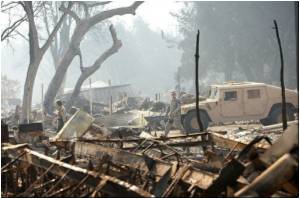Many of Mashiko's ancient pottery kilns were crushed by Japan's massive earthquake, which also left its world-famous ceramics in shards.

Workers from the 300-plus studios in this rural town cleared through the rubble to salvage unbroken works and rushed to create new ones in the surviving kilns for an annual spring pottery fair, Mashiko's biggest money-spinner.
Their fans came in droves -- 468,000 people flocked to a recent seven-day fair, despite the lingering fears of many of radiation wafting from the tsunami-crippled Fukushima nuclear plant 130 kilometres (80 miles) away.
The turnout during the string of holidays, although 20 percent below last year's, far exceeded the 300,000 visitors the town tourism office had expected.
"Many of us could not bake enough (ceramics), because the aftershocks have continued," said Susumu Kamiya, the head of the Mashiko potters' cooperative union. "But the big turnout has encouraged the potteries to go on."
Mashiko, long known for its utilitarian ceramics such as water jars and charcoal braziers, was put on the world map of pottery by the late master Shoji Hamada, who settled there in 1930 and died in 1978.
Advertisement
There were few international visitors at this year's fair and two-thirds of the roughly 30 foreign resident potters had left, if temporarily, said Mashiko tourism official Emi Ikeda. "Indeed, the nuclear problem had some impact."
"I felt many customers came and bought our works to cheer us up," said Tomoo Hamada, a grandson of the master potter. Shoji Hamada was designated as a "living national treasure" by the Japanese government in 1955.
"By the autumn pottery fair, well-heeled potteries here will have rebuilt their kilns," said the 44-year-old, who shares a studio with his father, renowned potter Shinsaku, 82. They run a museum in memory of the master.
"I believe we will be able to present something new and inspiring then."
On one afternoon during the fair, there was a long traffic jam outside dozens of outlets and workshops on Mashiko's main street.
"Gambaro (Hang on), Mashiko!" read a banner at the town's cooperative marketing centre, which was teeming with people looking for plates, teacups, bowls, vases, mascot figurines and other ceramic ware.
Kamiya noted a 10-20 percent decline from last year in sales among his union members, but donations have come pouring in from supporters in Japan and abroad to help Mashiko craftsmen.
At the Hamada pottery, a 20-metre (66-foot)-long climbing kiln was shattered along with a "few thousand works," Tomoo said.
"I'd better forget about how many."
The father and son were working at the studio on March 11 when the 9.0-magnitude quake hit 300 kilometres away in the Pacific and triggered a monster tsunami that left 25,000 dead or missing.
"I tried to hold up all the shelves, but I immediately realised it wouldn't help and ran to a safe place," he said.
"I can still remember how I felt when my works fell like rain from above."
No one was killed and seven people were injured in landlocked Mashiko, while 2,600 houses were damaged.
But the tremor left the town's pottery industry with damage estimated at 770 million yen ($9.6 million), nearly one fifth of its total annual sales, including 550 million yen needed to restore battered facilities.
It affected most of the town's 40 "noborigama", or traditional brick-made climbing kilns, which have stepped chambers with wood fires surging from the lowest section to the chimney at the top. However, many gas-fired kilns survived.
At the Shoji Hamada museum, which opened in 1977 on the late potter's hillside estate, one noborigama and another brick kiln were damaged, and the walls of stone warehouses were cracked.
Among its vast collection of works by Hamada, Leach and other associated potters, as well as of Asian antiques, about 500 pieces worth "hundreds of millions of yen" were shattered, Tomoo said.
"We will restore and display some of them again without compromising their charm, although their market value may have dwindled close to zero," he said.
The museum reopened in late April, and the works are now secured with fishing lines and adhesives bonding them to their showcases.
Two months after the disaster, said Tomoo, "we are firmly on guard against quakes."
Source-AFP








